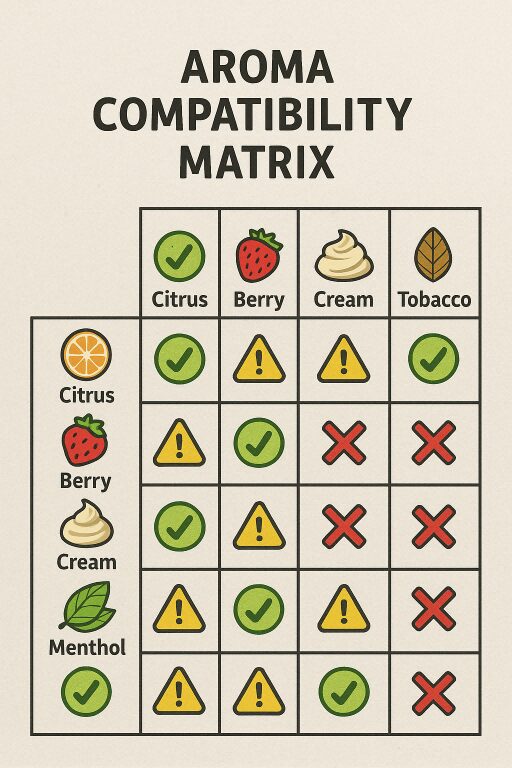
Color wheel intertwined with molecular structure
The creation of a truly exceptional e-liquid is an art form, but one deeply rooted in science. While individual flavor components might be tantalizing on their own, the real magic—or indeed, the major pitfall—lies in how they interact when blended. A common and frustrating challenge for e-liquid manufacturers is flavor suppression, where one or more aroma compounds in a blend diminish or entirely cancel out the perceived intensity and nuance of others. This leads to bland, unbalanced, or “muddy” flavor profiles that disappoint consumers.
The key to overcoming this lies in understanding aroma compatibility and utilizing a systematic approach to flavor selection, much like a compatibility matrix. This goes beyond simply combining appealing tastes; it delves into the complex molecular interactions and sensory neuroscience that dictate how flavors are perceived when presented together. By consciously selecting flavors that enhance rather than suppress each other, formulators can unlock unprecedented levels of complexity, clarity, and satisfaction in their e-liquids.
This article delves into the technical intricacies of aroma compatibility in e-liquid formulation. We will explore the scientific principles behind flavor suppression, the methodology for creating and utilizing a compatibility matrix, and how advanced flavoring strategies are essential for crafting harmonious, impactful, and ultimately superior vaping experiences.
Flavor perception isn’t simply additive. When multiple aroma compounds are present, they interact in complex ways on our olfactory and taste receptors. These interactions can lead to enhancement (synergy), neutrality, or, unfortunately, suppression.
1.Receptor Competition:Our taste and smell receptors have a finite number of binding sites. If two or more flavor molecules compete for the same receptor site, the more potent or abundant molecule can effectively block the perception of the weaker one.
(1)Example:A very strong, dominant fruity note might overwhelm and suppress a subtle, delicate floral or creamy undertone.
2.Cross-Adaptation:Prolonged exposure to one aroma can reduce the sensitivity of the olfactory system to subsequent or co-present aromas. While typically associated with extended exposure, rapid cross-adaptation can occur in complex blends, leading to reduced perception of certain notes.
3.Chemical Interaction/Degradation:
(1)Adsorption/Binding:Certain flavor molecules can bind to other ingredients (e.g., proteins if present, or even VG/PG in specific ways), making them less volatile and thus less perceivable.
(2)Chemical Reaction:Flavors can react with each other or with other e-liquid components (nicotine, solvents) over time or under heat, leading to the degradation of one or more flavor compounds or the formation of new, often undesirable, compounds. For example, some aldehydes (fruity notes) can react with amines (found in some nicotine salts) or ketones.
(3)pH Influence:The pH of the e-liquid (influenced by nicotine type and acids/bases in flavors) can selectively degrade or alter certain flavor compounds, leading to suppression.
4.Sensory Adaptation & Cognitive Fatigue:When too many disparate or overly intense flavors are present, the brain can struggle to process them all, leading to a “muddy” or indistinct flavor profile where individual notes are lost. This isn’t true chemical suppression but a perceptual one.
5.Volatility Differences:If one flavor component is significantly more volatile than another, it might be perceived much earlier and more intensely, masking less volatile components that are released later or more slowly during the puff.
Understanding these mechanisms is the foundation for proactive flavor selection using a compatibility matrix.
An Aroma Compatibility Matrix (ACM) is a systematic framework used by flavorists to predict and manage interactions between different flavor compounds or flavor types within a blend. It moves beyond trial-and-error blending, providing a more scientific and efficient approach.
1.Categorization of Flavors:Flavors are grouped into broad categories based on their chemical class, sensory profile, or source (e.g., Citrus, Berry, Tropical Fruit, Creamy, Bakery, Tobacco, Mint/Menthol, Spice, Floral).
2.Interaction Ratings:For each pairwise combination of flavor categories (or even specific key flavor molecules), an interaction rating is assigned. This rating can be qualitative (e.g., Synergistic, Compatible, Neutral, Suppressive, Clashing) or quantitative (e.g., a numerical score based on sensory evaluation data).
3.Data Collection (Sensory & Analytical):
(1)Sensory Evaluation:This is paramount. Trained sensory panels or expert flavorists systematically test binary and tertiary blends, noting perceived intensity, clarity, and the presence of off-notes or suppression. This data forms the core of the matrix.
(2)Analytical Chemistry:Techniques like Gas Chromatography-Mass Spectrometry (GC-MS) can identify volatile compounds and their concentrations before and after blending/storage/heating, helping to detect degradation or unexpected reactions. This provides objective data to support sensory findings.
(3)Predictive Modeling:Advanced computational models, leveraging data on molecular structure and receptor binding, are emerging to predict potential interactions.
4.Matrix Visualization:The data is often presented as a grid or heat map, making it easy to visualize compatible and incompatible pairings.
(1)Example:A row for “Strawberry” and a column for “Cream.” The cell where they intersect would indicate their compatibility (e.g., “Synergistic”). If “Strawberry” met “Strong Menthol,” the cell might indicate “Partial Suppression of Strawberry.”
5.Rules and Guidelines:The matrix informs general rules for blending:
(1)Avoid combining highly dominant flavors with very delicate ones without careful dosage adjustment.
(2)Be cautious when mixing flavors from vastly different chemical families unless specific interaction data proves compatibility.
(3)Consider the inherent pH of flavors and their stability with the chosen nicotine system.
Utilizing an ACM is just one part of the solution. Expert flavorists employ various strategies to build harmonious e-liquid blends.

Fragrance compatibility matrix chart
The pursuit of the perfect e-liquid flavor is a journey of continuous refinement. As consumer palates become more sophisticated, the demand for nuanced, clean, and non-suppressed flavor profiles will only intensify.
Manufacturers who strategically:
Forge strong partnerships with leading flavor experts like CUIGUAI Flavoring, will be uniquely positioned to lead in this dynamic industry. They will not only overcome the technical hurdles of flavor suppression but, more importantly, create e-liquids that consistently deliver an unparalleled, deeply satisfying vaping experience.

Colorful dance of smoke
In conclusion, the meticulous application of an Aroma Compatibility Matrix is a critical advancement in e-liquid flavor development. By systematically understanding and managing how aroma compounds interact, formulators can move beyond accidental suppression to intentionally craft blends that sing with clarity and complexity. This scientific approach, coupled with the expertise and advanced flavor solutions offered by partners like CUIGUAI Flavoring, is not just about avoiding problems—it’s about unlocking the full, harmonious potential of every flavor blend, leading to truly next-generation vaping experiences.
Keywords: flavor compatibility vape, suppression matrix, e-liquid flavor interaction, aroma blending science, flavor balance e-liquid, CUIGUAI Flavoring, optimal vaping flavors
Author: R&D Team, CUIGUAI Flavoring
Published by: Guangdong Unique Flavor Co., Ltd.
Last Updated: Aug 05, 2025
The business scope includes licensed projects: food additive production. General projects: sales of food additives; manufacturing of daily chemical products; sales of daily chemical products; technical services, technology development, technical consultation, technology exchange, technology transfer, and technology promotion; biological feed research and development; industrial enzyme preparation research and development; cosmetics wholesale; domestic trading agency; sales of sanitary products and disposable medical supplies; retail of kitchenware, sanitary ware and daily sundries; sales of daily necessities; food sales (only sales of pre-packaged food).
Copyright ©Guangdong Unique Flavor Co., Ltd.All Rights Reserved. Privacy Policy